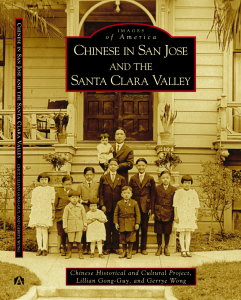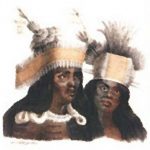Ethnic History & Culture

“This [country] will in a few years become a…colony; instead of [their] learning our language, we must learn theirs, or live as in a foreign country.”
– Advice to German immigrants from Benjamin Franklin, publisher of die Philadelphische Zeitung, the first German newspaper in America, 1751.
Immigrants speaking other languages have been arriving in Santa Clara County for about 2 centuries contributing to our diverse ethnic history. Eventually they learn English, and begin to call themselves hyphenated-Americans, and become part of this wonderful melting pot. But is being a hyphenated-American a good thing? Does it imply not being 100% American?
Our Ethnic Heritage
Knowledge of Immigrant Nationalities of Santa Clara County
Unless we all start from the premise that we are innocently ignorant of the background and conditions of the rich cultures in our midst, and are challenged to rise to new levels of human understanding and humane relations, we suffer the possibility of engaging in insensitive or even discriminatory behaviors.
Silicon Valley Cultures Project
A fifteen year ethnographic study of the cultures living and working in the hi-tech communities of Silicon Valley.
Black Heritage
 Black History Community Resources
Black History Community Resources
KQED has long list of resources in the Bay Area to assist you in studying Black History.
A History of Black Americans in California
Although Afro-American people were comparatively few in number before World War II, they were settled throughout the state and made significant contributions to its development and growth. National Park Service.
Two Years a Slave in the Santa Clara Valley: Sampson Gleaves and Plim Jackson
The manumission papers of Sampson Gleaves and Plim Jackson, preserved today at History San Jose, are rare in California, and provide clear evidence of African-American slavery in the Gold Rush state.
Chinese
 Angel Island: Immigrant Journeys of Chinese-Americans
Angel Island: Immigrant Journeys of Chinese-Americans
Between 1910 and 1940, there were as many as 175,000 Chinese immigrants detained and processed at Angel Island, San Francisco Bay, California. Unlike Ellis Island in New York’s harbor, Angel Island is a visible reminder of a shameful period in U.S. immigration history.
Asian-Nation
Your one-stop information source on the historical, political, demographic, and cultural issues that make up today’s diverse Asian American community. You can almost think of Asian-Nation as an online version of “Asian Americans 101.”
Pacific Link: The KQED Asian Education Initiative
A complete study of the role of Asian immigrants in the history of California. From KQED.
Chinese Historical & Cultural Project
Based in Santa Clara County, California, it was founded in 1987 as a non-profit organization to promote and preserve Chinese American and Chinese history and culture through community outreach activities.
A History of Chinese Americans in California
Amid the increased numbers of Chinese immigrants in recent years, it should be remembered that not all Chinese Americans are recent arrivals.
Filipino
Context for Filipino Immigration
In Santa Clara County, 60% of randomly surveyed Filipinos cited economic problems as the main reason they left the Philippines. Fifty three percent also reported a desire to reunite with family. Similarly, 65% of public benefits recipients cited family reunification as the main reason they left their home country. The Filipino community is scattered in the suburbs of San Jose, Milpitas, Santa Clara, and Sunnyvale. While most speak English, many do not consider it their first nor most frequently used language.
Germans & Swiss
Die Deutschen in Kalifornien: Germans in Urban California, 1850-1860
A scholarly thesis by Carole Cosgrove Terry. The society that the European and American newcomers created in urban California was a combination of individual, ethnically-centered but unstructured cultural communities where the German-Californians were an influential and important segment of the citizenry.
Johann August Sutter
General Sutter, as he was generally known, was forced to flee his creditors in Switzerland at the age of 30. Ten years later, in California, he was the “ruler of the Saccramento Valley, founder of New Helvetia, a small sovereign.” After the discovery of gold on his land, he lost everything.
 The WWI Home Front: War Hysteria & the Persecution of German-Americans
The WWI Home Front: War Hysteria & the Persecution of German-Americans
Anglo-Saxons had their own definition of what was “American”, and anything that did not conform was an undesirable deviation, perhaps even dangerous. And they were having trouble understanding why German-Americans would not willingly give up their German culture.
Hispanic
Early History of Santa Clara County
Although Mexico broke with the Spanish crown in 1821, it was not until May 10, 1825, that San Jose acknowledged Mexican rule. On May 13, 1846, the United States declared war on Mexico. Captain Thomas Fallon, leading 19 men, entered San Jose on July 14, 1846, and raised the United States flag over the town hall.
A History of Mexican Americans in California
The roots of the Chicano experience stretched back some three centuries to 1519 when Spaniards and their Indian allies carried out the conquest of the Aztec Empire in central Mexico and established what they called “New Spain.” National Park Service.
Irish
 California and Bay Area Irish History: The Murphy Family
California and Bay Area Irish History: The Murphy Family
Martin and his family, Irish immigrants whose search for religious and educational freedom led them to California, were the first English speaking family to settle in Santa Clara Valley in 1849. From his home, Martin introduced the area’s first orchards and modern farm equipment and helped to establish the state’s first schools. In Milpitas we have a park named “Murphy.” The Shaughessy-Murphy Milk Shed still exists at the sewage pump facility near Coyote Creek.
The Irish in California
It is fashionable today, in some circles, to ignore, or at least minimize, the contributions of anyone from Europe. My intent is to point out, in a small way, how important the Irish were to the development of this state.
Japanese
History of Japantown, San Jose
Japanese, new to the country, eventually chose to build their wooden buildings next to Chinatown. Because the Chinese had already settled there, the environment was more familiar to them.
A History of Japanese Americans in California
How the National Park Service selects sites to show the history and contributions of Japanese in our state. A site both to find history and directions to historical sites.
Japanese American Museum of San Jose
Step into the past and help us honor our community’s stories of sacrifice, hardship and resilience. We invite you to come and engage with the firsthand experiences of Japanese Americans who experienced the racial tension and hysteria of WWII.
Japantown, San Jose
San Jose’s Japantown (Nihonmachi) developed from where the immigrant Japanese first settled in Santa Clara Valley. More than a century following its humble beginnings, it remains one of the last three historical Japantowns in the United States.
Native Americans
Indigenous People (Indians) of Silicon Valley
History of the Ohlone Indians who inhabited the south San Francisco Bay region of California.

